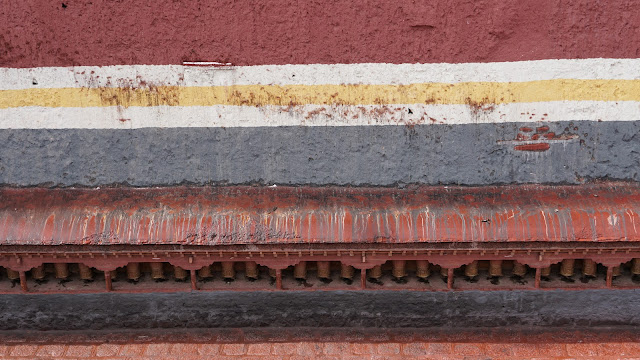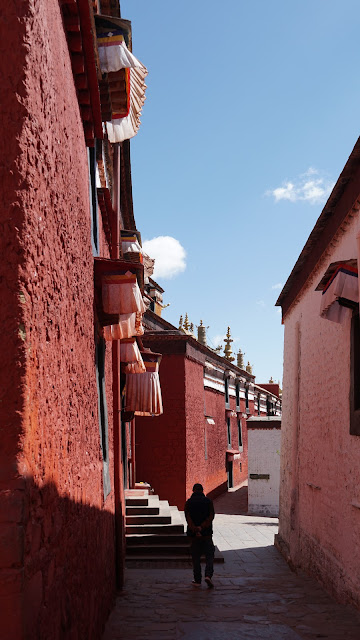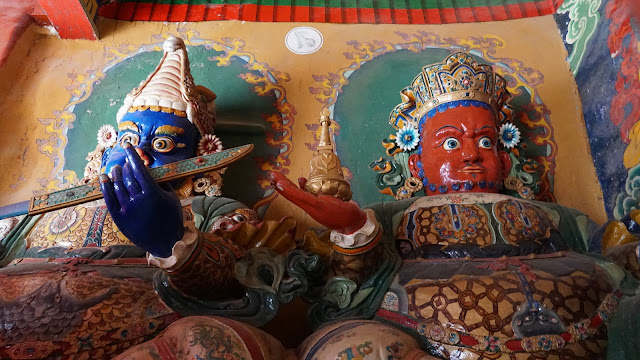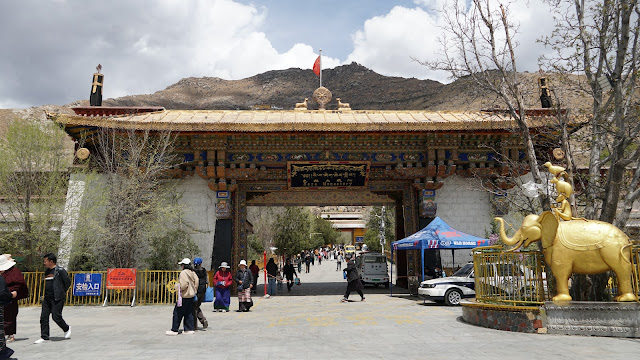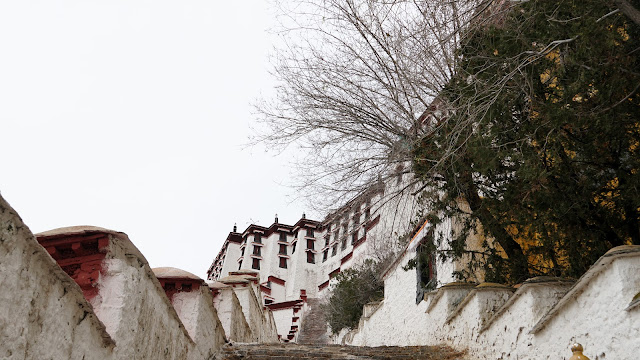Day 1
Start/End: Banak Shol Hotel
1: Barkhor Street 八廓街
Day 2
Start/End: Banak Shol Hotel
1. Drepung Monastery 哲蚌寺
2. Sera Monastery 色拉寺
Day 3
Start/End: Banak Shol Hotel
1. Jokhang Temple 大昭寺
2. Barkhor Street 八廓街
3. Guangming Gangqiongtian Tea House 老光明岗琼甜茶馆
4. Potala Palace 布达拉宫
'Lha' translates to "deity", "god" or "divine" while 'sa' translates to "land", "soil" or "earth". So Lhasa - the Land of the Gods.
Lhasa rose as an important administrative centre in the 7th century AD, when the 33rd Tibetan king of the Yarlung dynasty, King Songtsen Gampo (601- 683 CE, reign 614 - 648) moved his capital from Yarlung Valley to Lhasa and built a palace on the site now occupied by the Potala. It was also at this time that the temples of Ramache and the Jokhang were founded to house the priceless first Buddha statues brought to Tibet as the dowries of King Songtsen Gampo's Chinese and Nepali queens - Princess Wencheng and Princess Bhrikuti.
Following the fall of the monarchy in the 9th century, the centre of the political power of the Tibetan region was shifted to Sakya, Nedong (Ü) and then Shigatse (Tsang) till the 5th Dalai Lama, Lobsang Gyatso (1617 - 1682) unified Tibet and moved the centre of his administration to Lhasa in 1642 with Mongol support.
By the 15th century, the city of Lhasa had risen to prominence following the founding of three large Gelugpa monasteries by Je Tsongkhapa and his disciples. The three monasteries are Ganden, Sera and Drepung which were built as part of the puritanical Buddhist revival in Tibet. The scholarly achievements and political know-how of this Gelugpa Lineage eventually pushed Lhasa once more to centre stage.
Drepung Monastery 哲蚌寺
Drepung onastery,lso ed Tashi-Megyur-Chakju-Ling is one of the six largest monasteries of the Gelupa Sect. It is located at the foot of the West Valley Mountain (Gyepbel-Ou-Tse) about 10 km from Lhasa. Drepung translates as 'rice heap', referring to a huge numbers of white monastic buldings that once piled up in the hillside.
Drepung was founded in 1416 by Jamyang Choge Tashi Palden, one of Tsongkhapa's main disciple. Over ten thousand monks resided there before Liberation, making it the largest monastery in Tibet. It has six main temples - Ganden Palace (Ganden Phodrang), Toschen, Ngakpa, Losaling, Gomang and Dyeyang. The Ganden Phodrang in Drepung was the residence of the Dalai Lamas until the Great Fifth Dalai Lama constructed the Potala.
 |
| "Om mani padme hum" |
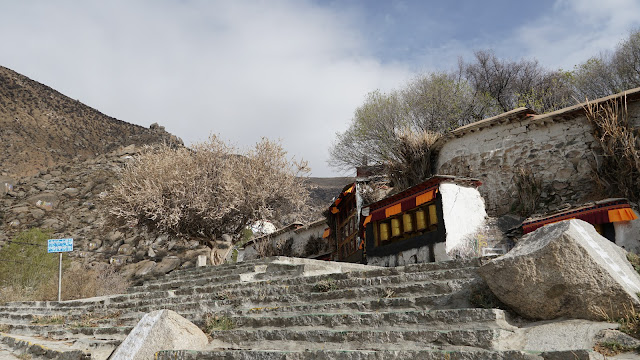 |
| Prayer wheels are turned clockwise |
 |
| Scroll in prayer wheel |
 |
| Wall to hang thangka |
 |
| Ganden Palace (Ganden Phodrang) - the former residence of the Dalai Lamas |
 |
| Coqen Hall (Tsokchen Lhakhang) - the main assembly hall of Drepung Temple |
 |
| We were given permission to take photos inside this hall |
Sera Monastery 色拉寺
Sera Monastery was founded by Jamchen Choje Shakya Yesh who was a disciple of Tsongkhapa in 1419. Sera Monastery has an Assembly Hall, three colleges and thirty three houses. The monastery's construction covers an area of 114,964 square meters. It is the second biggest monastery of Tibet, after Drepung.
Outside of Sera Monastery, there are statues of the "Four Harmonious Friends" - elephant monkey, rabbit and rooster. The story tells of how the four animals, despite their differing strengths and weaknesses, learned to help each other. The elephant, with his strength, supported the other animals to reach a fruit-laden tree. The monkey climbed the tree and dropped the fruits for the others. The rabbit helped the others with carrying the fruits and the rooster, believed to be the oldest of the group, provided guidance and knowledge.
On weekday afternoons from around 3 pm to 5 pm, there is a debating practice at Sera Monastery's debating courtyard. The debate is an important session to study and discuss about five major text in Tibetan Buddhism. During the debate, monks would debate vigorously by employing some gestures like hand clapping to enliven the ambience.
Jokhang Temple 大昭寺
Jokhang Temple is situated in the center of old Lhasa. The estimation of Jokhang's founding range from 639 to 647 A.D. during the time of Tibetan King Songtsan Gampo to house an image of Mikyoba (Akshobhya) brought to Tibet as part of the dowry of his Nepali wife Princess Bhrikuti. The Ramache Temple was constructed at the same time to house another Buddha image, the Jowo Sakyamuni, brought to Tibet by his Chinese wife Princess Wencheng.
It is said that the Jowo Sakyamuni was moved from Ramoche for its protection and hidden in the Jokhang by Princess Wencheng after the death of Songtsen Gampo. The image has remained in the Jokhang ever since. The Jokhang takes the size like it is today after extensions in later period.
Our visit coincided with the 2025 Tibetan Buddhist academic degree Geshe Lharampa award ceremony. "Geshe" means intellectual in Tibetan language and "lharampa" title is the highest of four levels in Gelug school degree teaching. The academic tradition of Geshe degrees dates back roughly 900 years, with the Lharampa title established about 400 years ago.
In 2025, thirteen monks were awarded the prestigious Geshe Lharampa, equivalent to a doctorate in mainstream higher education. The monks, hailing from temples across Tibet and Yunnan Province, participated in the formal debate and award ceremony. During our visit, the debate already started and still ongoing when we left.
 |
| Tibetans prostration outside of Jokhang Temple |
 |
| Guardian Kings |
 |
| Guardian Kings |
 |
| Ongoing debate during lunch time, and the graduates |
Barkhor Street 八廓街
Barkhor is a quadrangle of streets that surrounds the Jokhang complex. Barkhor Street was first a circumambulation circuit around the Jokhang Temple. This circumambulation circuit refers to walking around the Jokhang Temple in the clockwise direction, which shows worship to the bronze statue of Sakyamuni enshrined in the temple. It is one of the three famous circumambulation circuits in Lhasa. The other two being Lingkhor (outer circumambulation circuit) around the old city zone; and Nangkhor which is the circumambulation corridor encircles the inner precincts of the Jokhang Temple.
We went to the Barkhor Street on the day we arrived in Lhasa and our guide were pleased that we did two rounds of kora. This was mainly because we wanted to go back to one of the shops and the right way is going clockwise. We also did one round of kora after visiting the Jokhang Temple.
Guangming Gangqiongtian Tea House 光明岗琼甜茶馆
Tea is a big thing in Tibet with option of butter tea and sweet tea. We were told that outside of the city area, most locals drink butter tea but sweet tea is more popular in city area. Sweet tea is made of black tea, milk and white sugar. We had a stop at a local tea house before lunch. Most people just drink tea, only a handful ordered food.
The guide found us seats at a table, grabbed 3 glasses from the counter and left some notes on the table. The staffs went around with a kettle and poured tea to empty glasses and payment is made to the staff directly.
Potala Palace 布达拉宫
Lhasa's cardinal landmark and home to every Dalai Lama from the fifth to 14th. The Potala is built on the site of palace Songtsen Gampo on the Red Hill. The fifth Dalai Lama started the construction of the modern Potala Palace in 1645 after being pointed out that the site was ideal as a seat of government, situated between Drepung and Sera monasteries and the old city of Lhasa.
The White Palace (Kharpo Podrang) was built in 3 years after work first began in 1645. However, the construction of the larger Red Palace (Marpo Podrang) were subject to some dispute and took much longer. The construction were still ongoing when the fifth Dalai Lama died in 1682 and this death was concealed until the completion of the Red Palace 12 years later. The death of the fifth Dalai Lama was not announced until he was put to rest in the newly completed Red Palace.
Since its construction, the Potala has been the home of each of the successive Dalai Lamas, although since construction of the Norbulingka summer palace in the late 18th century, it served as a winter residence only.
The entry to the Potala was organised by our guide but we were told of an appointment time to follow. There was also a 60 minutes time restriction to visit the inside of the Potala. We were told that fine applies when time is exceeded. Fine is calculated based on seconds exceeded. The tour company or guide could also be banned from booking an appointment to Potala for a period of time.
 |
| White walls painted with mixture of milk, honey, sugar, lime and saffron |
 |
| White Palace |
Side note: Temperature control kettle is awesome






